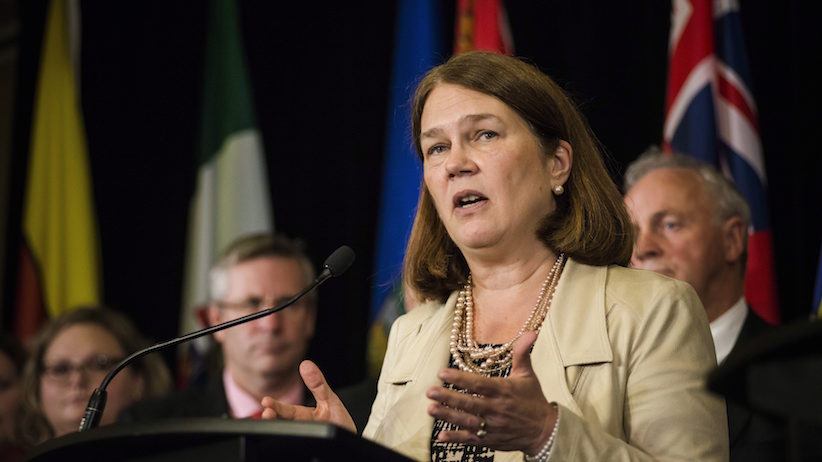Jane Philpott moves on. Health Canada’s drug problems remain.
The outgoing health minister leaves behind some of Ottawa’s hottest files, from the opioid crisis to a less-than-transparent drug-safety system
Minister of Health Jane Philpott and International Development Minister Marie-Claude Bibeau speak to reporters in the House of Commons foyer on Parliament Hill in Ottawa on Wednesday, May 11, 2016, regarding investments in the global fight against the Zika virus. (Sean Kilpatrick/CP)
Share

On August 24, four days before Monday’s surprise cabinet shuffle, Health Minister Jane Philpott addressed the annual meeting of the Canadian Medical Association in Quebec City. Her speech, directed to the needs of the most “vulnerable” Canadians, now reads as foreshadowing, even a dress rehearsal, for her new, as-yet-undefined role as Minister of Indigenous Services in a reconfigured Indigenous and northern affairs department. The medical doctor focused on three areas—“Indigenous Health,” “The Epidemic of Opioid Overdose Deaths” and “Youth Mental Wellness,” all which are vitally important. “For Canada to thrive, we need to improve the health of our most vulnerable people,” Philpott, a medical doctor, told the assembly. “To do so successfully, we need Canada’s doctors to be actively engaged in population health.”
No question the portfolio switch-up will thrust the spotlight on the Liberal government’s bid to redress its record on the Indigenous affairs file—as well as on the devastation the opioid crisis has wracked on the poor and disenfranchised. Yet it’s crucial not to forget that Philpott leaves Health Canada amid mounting pressure to address an issue that affects all Canadians—rich and poor: the need for greater transparency around the dangers of prescription drugs, not only opioids.
Just this past week, the ministry came under criticism for “gutting” an important drug safety bill, Protecting Canadians From Unsafe Drugs Act, passed unanimously by the House of Commons and Senate in 2013. This bill, dubbed “Vanessa’s Law,” calls for seismic change in reporting adverse drug reactions: it made it mandatory for health-care institutions to report, imposed stiffer penalties on unsafe products and enabled swifter regulatory action such as a product recall or label change. The legislation was introduced by Terence Young, Conservative MP for Oakville, Ont., following personal tragedy: his 15-year-old daughter, Vanessa, died of a heart attack in 2000 after taking a prescription drug for a minor eating disorder (it was later removed from market). Canadians who died from taking prescription drugs exactly as prescribed comprise an undiscussed demographic: an estimated 10,000-plus people annually. (That figure, extrapolated from a 19-year-old study led by University of Toronto researchers and published in the April 1998 Journal of the American Medical Association, is likely low. A 2011 Health Council of Canada study estimated that 150,000 people annually experience serious reactions from prescription drugs.)
RELATED: Playing the Jane Philpott card: Trudeau shuffles the deck
Young, who lost his seat in the 2015 election, has been vocal in his criticism that the government is de-fanging the legislation and will not require all serious adverse drug reactions be reported. Failing to do so would set the country back a decade on prescription drug safety, he says. It also raises questions about who the government was trying to protect—drug companies or the public? Young reports receiving a letter from the minister in May saying she’d welcome the opportunity to discuss the law’s implementation. That meeting never happened—leaving Philpott’s successor, New Brunswick MP Ginette Petitpas Taylor, to deal with it.
Only two weeks ago Philpott received an open letter from 17 physicians demanding Canada finally implement an equivalent of the U.S. “Physician Payments Sunshine Act,” legislation that requires drug companies to release details of payments to individual doctors and hospitals in excess of $10. The letter came days after the American Journal of Public Health published a survey reporting opioid makers spent more than $46 million on payments to U.S. doctors—one in 12—between 2013 and 2015. (Such compensation takes various forms: research funding, payment for speeches, participating on advisory committees and travel expenses paid so they can participate in international conferences.)
RELATED: Jane Philpott on drug policy: ‘We must do better for our citizens’
The extent to which Canadian doctors’ opioid prescription habits is influenced by drug money isn’t clear, though worrying signs abound. A Globe and Mail review in May found one-third of the 28 medical experts, academics and patient advocates who worked on new national prescribing guidelines for opioids received remuneration from drug companies; Philpott ordered an independent review. One of these companies was Purdue Pharma, the pharmaceutical giant whose pain pill has been held responsible for Canada’s deadly opioid epidemic. Purdue was one of the 10 pharmaceutical companies that voluntarily disclosed its 2016 payments to doctors in Ontario ($2.06 million), without naming doctors who received the money, as is required in the U.S.
The open letter to Philpott is part of ongoing pressure on the feds led by Ontario’s Open Pharma campaign, spearheaded by physician Andrew Boozary and backed by health-care workers and academics. The group is calling on Ottawa to publicly disclose clinical information on safety and efficacy of drugs and medical devices, and for industry-funded research to be made open access so it is available for scrutiny and reanalysis.
Canada is in the Dark Ages when it comes to drug transparency, the letter’s authors write: “It is long past time for Canada to follow the lead of other developed nations in bringing transparency to the financial dealings between pharmaceutical companies and prescribers.” At the time, Philpott, who has routinely deflected responsibility to the provinces, which have jurisdiction over health care, appeared responsive. She promised to review the group’s ideas, and insisted that her government remains “open to new approaches to increase transparency for Canadians.” Certainly greater transparency around prescription drugs is desperately needed in Canada. Let’s hope the latest cabinet shuffle doesn’t blur the issue even more.